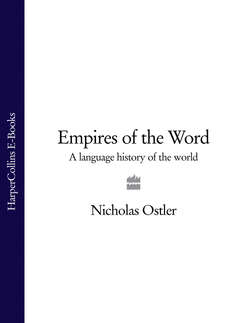Читать книгу Empires of the Word: A Language History of the World - Nicholas Ostler - Страница 39
Beyond the southern sea
ОглавлениеAlthough Chinese has spent its three and a half millennia almost wholly confined to East Asia, it did put out some feelers across the sea to its south. In the last thousand years, this led to some permanent residence of Chinese abroad; in the last two hundred, partly as a reaction to—or exploitation of—European settlement, serious overseas communities have grown up, which may be significant in the future spread of the language.
The earliest inklings of Chinese in Nán-yáng, ‘the Southern Ocean’, as the Chinese called the shores of the South China Sea, are visits of merchants to Tongking (northern Vietnam) in the third century BC.19 They were followed up in 111 BC by troops, and China annexed Tongking, along with Nan-yue* (modern Guangxi and Guangdong). China was to hold Tongking for over a thousand years, in fact until AD 938, despite sporadic and increasing resistance. China attempted to assimilate it culturally, with Chinese classics for the local elite, competitive examinations for administrators, and official use of wényán. There was Chinese immigration, and some married into Vietnam’s princely families, providing many later leaders. Mahayana Buddhism, introduced under the Tang dynasty, became the majority religion.20 Despite all this, the Chinese language did not spread permanently to this part of the world.
Somewhat later than the advance into Tongking, Chinese proceeded farther south, though apparently with instincts more scholarly than materialist. In the third century AD, two Chinese envoys, Kang Tai and Ju Ying, wrote a report on the foundation of Funan (in modern Cambodia).21 There is little more to be said of it, or what the Chinese were doing there; but the route via Śri Vijaya (in Sumatra) to India became quite well travelled by China’s Buddhist scholars a little later, in the fifth to eighth centuries. (See Chapter 5, ‘Outsiders’ views’, p. 192.)
After the eighth century, trade comes to the fore as a motive, but the links seem to have been maintained by foreign merchants, Arabs, Persians and Indians, and it is only in the eleventh century that we find the first reports of capital-raising by Chinese merchants to finance their own expeditions. This was under the Song dynasty, which actively backed the traders. Thereafter government support for overseas expansion wavered, the Mongol Yuan staunchly in favour, even making a failed endeavour to invade Java in 1293, the Ming who succeeded in 1368 preferring isolation: private trade was banned, and all contacts had to be made through diplomatic channels. There was a brief resurgence during the famous global voyages of Admiral Zheng-He (in the period 1405–33); but after that episode resident Chinese merchants had, for a time, to go underground.
Most of the Chinese who had taken to this life came from Fujian, with a smaller contingent from Guangdong, a fact which is explicitly recorded in a fifteenth-century report, Yíngyái Shènglăn: The Overall Survey of the Ocean’s Shores, by Ma Huan, one of the sailors with Zheng-He. Ma writes, of two states in Java, ‘Many people from Guangdong and Zhangzhou are staying there,’ and he mentions many other exiles from Fujian elsewhere in the island.22 The truth of this stands out very clearly in the predominance of Min, Hakka and Yue, south-eastern dialects, in the speech of overseas Chinese to this day.*
